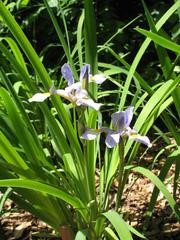Iris versicolor
 Latin name: Iris versicolor12
Latin name: Iris versicolor12
Common name: Harlequin Blueflag16
Flowers: Color, violet blue, bloom May to June, Blooms 8” to 32” tall. Flowers are showy.12
Fruit: Inconspicuous5
Height & Width: 2.5’ X 2.5’12
Type: Perennial12
Habit: Upright12
Wetland indicator category: OBL16
Texture: Coarse3
Growth rate: Varies by species and type5
Light: Full sun to part shade12
Moisture: Medium to wet12
Soil: 6.8pH19
Zones: 3 to 912
Origin: Eastern United States16
Ecosystem benefits: This is a poisonous plant that grows in marshes, swamps, wet meadows, ditches and shorelines from Manitoba to Nova Scotia south to Virginia, Ohio, Illinois and Minnesota12. This plant attracts hummingbirds, but is poisonous to livestock10.
Features: Has violet blooms in May through June standing 8 to 32 inches tall. This perennial grows well in the eastern United States and constant moist soil where other plants do not thrive12.
Siting: Iris Versicolor prefers medium to wet soils and prefers an area of about 2.5’ X 2.5’ with 6 to 8 hours of full sun12. This plant would be suitable on the side of a wetland or rain garden.
Care: Plant crown at soil level18. At planting, water the roots and surrounding area slowly and deeply. Keep soil moist until plant is established, then apply enough water to thoroughly moisten the root zone when the soil is dry or during drought. Modify water recommendations to reflect site drainage and rainfall. Apply 3” of mulch over the planted area. Do not allow mulch to touch the plant stems18. Remove old blooms and stalks promptly after flowering to allow the plant to devote its energy to growth rather than seed. Removing old blooms and stalks also encourages repeat flowering on reblooming iris. For a stainable landscape, the old blooms can also be left for wildlife to benefit from18.
Pests: Iris borer is the most serious insect pest of iris and aphids can be a nuisance problem at times. Plants are relatively pest resistant if cultural preferences are met4.
This plant does not appear on the following invasive plant lists on (2/10/2016):
X USDA SC Invasive Plant Species Web site at http://www.invasivespeciesinfo.gov/plants/main.shtml
X SC Exotic Plant Pest Council Web site at http://www.se-eppc.org/southcarolina/
Sources:
Sources 1-18 found on Sources page
Image source: http://www.missouribotanicalgarden.org/PlantFinder/PlantFinderDetails.aspx?taxonid=281141&isprofile=0&
19. http://www.irises.org/About_Irises/Cultural%20Information/Grow_Bearded.html
